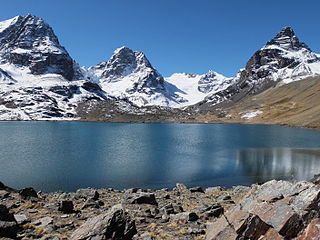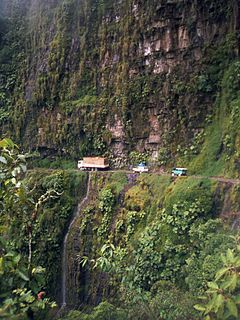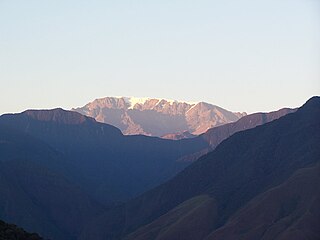
Bolivia, officially the Plurinational State of Bolivia, is a landlocked country located in western-central South America. The constitutional capital is Sucre, while the seat of government and executive capital is La Paz. The largest city and principal industrial center is Santa Cruz de la Sierra, located on the Llanos Orientales, a mostly flat region in the east of the country.

Jujuy is a province of Argentina, located in the extreme northwest of the country, at the borders with Chile and Bolivia. The only neighbouring Argentine province is Salta to the east and south.

The La Paz Department of Bolivia comprises 133,985 square kilometres (51,732 sq mi) with a 2012 census population of 2,706,359 inhabitants. It is situated at the western border of Bolivia, sharing Lake Titicaca with adjacent Peru. It contains the Cordillera Real, which reaches altitudes of 6.6 kilometers (4.1 mi). Northeast of the Cordillera Real are the Yungas, the steep eastern slopes of the Andes Mountains that make the transition to the Amazon River basin to the northeast. The capital of the department is the city of La Paz and is the administrative city and seat of government/national capital of Bolivia.

The Yungas is a narrow band of forest along the eastern slope of the Andes Mountains from Peru, Bolivia, and northern Argentina. It is a transitional zone between the Andean highlands and the eastern forests. Like the surrounding areas, the Yungas belong to the Neotropical realm; the climate is rainy, humid, and warm.

Sud Yungas or Sur Yungas is a province in the Bolivian department of La Paz. It was created during the presidency of José Manuel Pando on January 12, 1900. The capital of the province is Chulumani.

Caranavi Province is one of the twenty provinces of the Bolivian La Paz Department and is situated in the department's eastern parts. The province was created by Law 1401 on 16 December 1992 from a portion of what was then Nor Yungas Province. The creation of the province had been a local cause embraced by Ramiro Revuelta, a Deputy in the national legislature who was assassinated on November 28, 1992.

Nor Yungas is a province in the Yungas-area of the Bolivian department of La Paz. During the presidency of José Manuel Pando the Yungas Province was divided into two parts, the Nor Yungas and the Sud Yungas Province, by law of January 12, 1899. Its administrative seat is the town of Coroico.

Pedro Domingo Murillo is a province in the Bolivian La Paz Department. It was created on January 8, 1838, with the name Cercado and on October 17, 1912, during the presidency of Eliodoro Villazón, its name was changed in honor of Pedro Domingo Murillo, protagonist of the revolution of June 16, 1809.

Caranavi is the capital of the Caranavi Province in the Yungas region of Bolivia.

Coroico is a town in Nor Yungas Province, in the La Paz Department of western Bolivia.

Afro-Bolivians are Bolivian people of Sub-Saharan African heritage and therefore the descriptive "Afro-Bolivian" may refer to historical or cultural elements in Bolivia thought to emanate from their community. It can also refer to the combining of African and other cultural elements found in Bolivian society such as religion, music, language, the arts, and class culture. The Afro-Bolivians are recognized as one of the constituent ethnic groups of Bolivia by the country's government, and are ceremonially led by a king who traces his descent back to a line of monarchs that reigned in Africa during the medieval period. They numbered 23,330 according to the 2012 census.

Pilón Lajas Biosphere Reserve and Communal Lands is a protected area in Bolivia located in the departments of La Paz and Beni, in their northern and western parts, respectively, about 350 km northeast of La Paz and 50 km west of San Borja. It lies largely within the Bolivian Yungas ecoregion. The main river that flows in the Pilon Lajas area is the Quiquibey River.

Isiboro Sécure National Park and Indigenous Territory is a protected area and Native Community Land in Bolivia situated between the north of the Cochabamba Department and the south of the Beni Department. It protects part of the Bolivian Yungas ecoregion. The indigenous people living within the park belong to the Tsimané, Yuracaré, and Mojeño-Trinitario peoples. The southern portion of the park has been colonized by agricultural settlers, primarily coca farmers, since the 1970s. The Bolivian government estimates that 10% of the park has been deforested by their presence.

La Paz Municipality is the capital municipality and one of the five municipalities of the Pedro Domingo Murillo Province in the La Paz Department in Bolivia. Its seat is La Paz.

Cutusuma is a location in the La Paz Department in Bolivia. It is the seat of the Villa Asunta Canton, one of the five cantons of the Chulumani Municipality in the Sud Yungas Province. At the time of census 2001 it had 331 inhabitants.

Ocobaya is a location in the La Paz Department in Bolivia. It is the seat of the Ocobaya Canton, one of the five cantons of the Chulumani Municipality in the Sud Yungas Province. At the time of census 2001 it had 269 inhabitants.

Coca has been cultivated in medium-altitude parts of the Bolivian Andes since at least the Inca era, primarily in the Yungas north and east of La Paz. Cultivation expanded substantially in the 1980s into the Chapare region of Cochabamba and some production flowed into the international cocaine market. The US-backed efforts to criminalize and eradicate coca as part of the War on Drugs were met by the cocalero movement's growing capacity to organize. Violence between drug police and the Bolivian armed forces on one side and the movement on the other occurred episodically between 1987 and 2003. The cocaleros became an increasingly important political force during this period, co-founding the Movement for Socialism – Political Instrument for the Sovereignty of the Peoples party. Coca growers from both the Yungas and the Chapare have advocated for policies of "social control" over coca growing, maintaining a pre-set maximum area of cultivation as an alternative to drug war policies. In 2005, cocalero union leader Evo Morales was elected president of Bolivia. Morales has pursued a combined policy of legalizing coca production in the Chapare and Yungas and eradication of the crop elsewhere.

Qutapata is a 5,288-metre-high (17,349 ft) mountain in the Cordillera Real in the Bolivian Andes. It is situated in the La Paz Department, Murillo Province, La Paz Municipality, near the border with the Sud Yungas Province, Yanacachi Municipality. Qutapata lies south-west of the mountain Sirk'i Qullu, west of the mountain Jathi Qullu and south of the lake Sirk'i Quta.

Kimsa Warmini is a 2,842-metre-high (9,324 ft) mountain in the Bolivian Andes in a small range of that name. It is located in the La Paz Department, Nor Yungas Province, Coroico Municipality, northeast of Coroico. The range extends in a north-easterly direction.



















